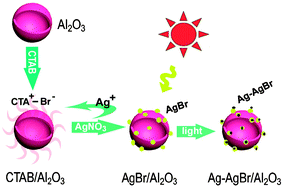Visible light-driven photocatalysts have attracted a great deal of attention for their direct use of solar energy. In this paper, an efficient and low-cost visible light-driven composite photocatalyst, comprising of Ag–AgBr/γ-Al2O3 nanostructures, has been facilely prepared by a surfactant-controlled precipitation–deposition and subsequent light-driven route. Hollow flower-like γ-Al2O3 nanostructures was chosen as the support. CTAB controlled the size of the deposited nanoparticles in both the Br source and the surfactant. The microstructures, surface chemical composition, visible light-driven photocatalytic performance and mechanism have been investigated systematically by SEM, TEM, XPS and so forth. The Ag–AgBr nanoparticles were distributed uniformly on the surface of the hollow flower-like γ-Al2O3 nanostructures, whose specific surface area value reached 116.5 m2 g−1. The Ag–AgBr/γ-Al2O3 composite nanostructures exhibit photocatalytic advantages over pure Ag–AgBr nanoparticles, such as decomposing aromatic compounds and organic dyes within several minutes of visible light irradiation. They also have good stabilities meaning the photocatalytic activity seldom decreases even when used 5 times under visible light irradiation. Meanwhile, the amount of Ag–AgBr needed and the cost decreases significantly. Thus, the as-prepared composite photocatalyst, consisting of Ag–AgBr/γ-Al2O3 nanostructures, will be an efficient and low-cost material for the removal of organic pollutants under visible light irradiation.

You have access to this article
 Please wait while we load your content...
Something went wrong. Try again?
Please wait while we load your content...
Something went wrong. Try again?


 Please wait while we load your content...
Please wait while we load your content...